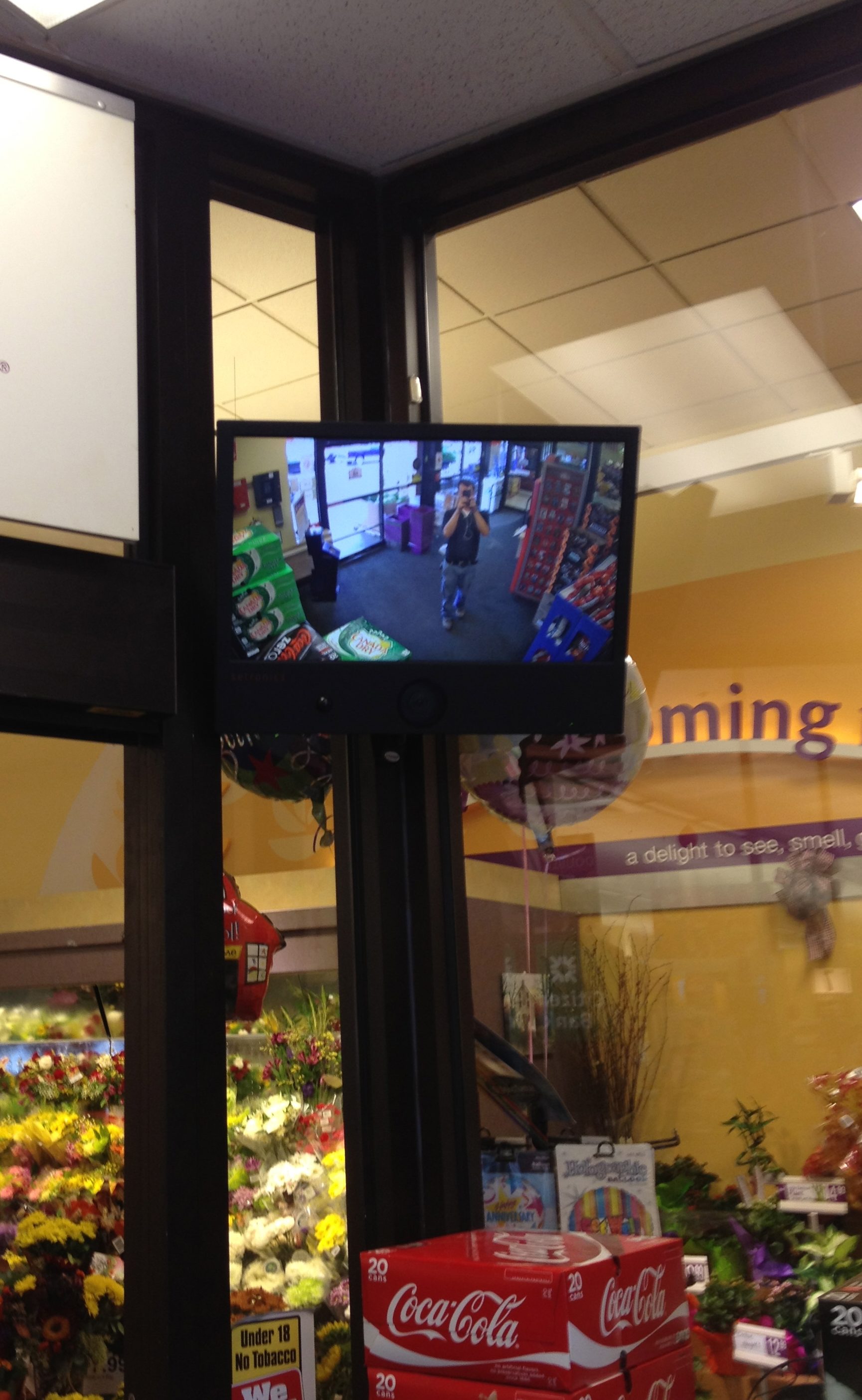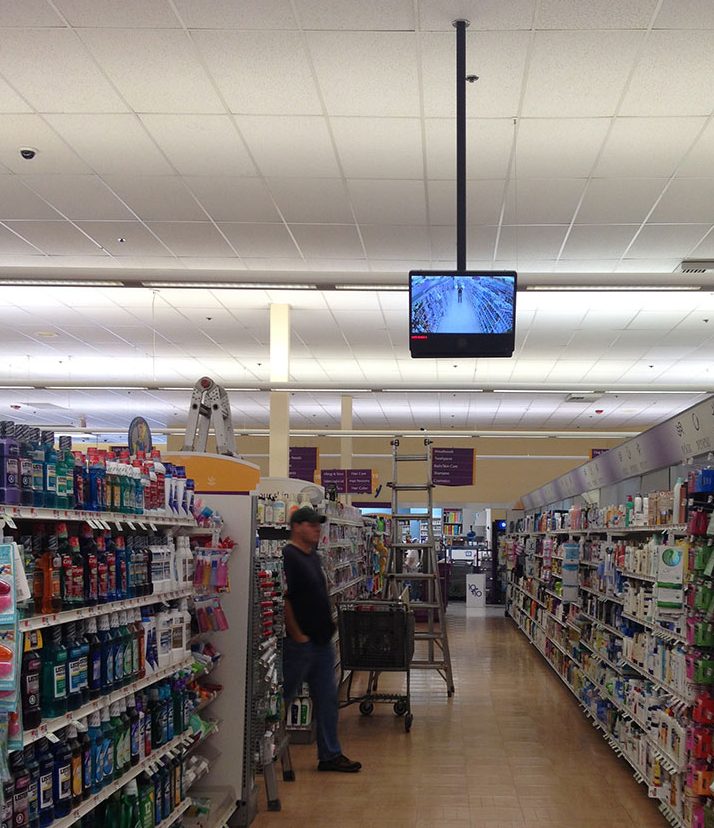active public view monitors - shoplifting deterrent, marketing, or both?
 Shoplifting is big business. Retail businesses in markets such as food, high end apparel, even technology have had to devote considerable money and personnel to combat it. One recent estimate (published by the US Congressional Research Service) was that in the US $11B is lost annually due
Shoplifting is big business. Retail businesses in markets such as food, high end apparel, even technology have had to devote considerable money and personnel to combat it. One recent estimate (published by the US Congressional Research Service) was that in the US $11B is lost annually due
to shoplifting. This figure includes both amateur shoplifting as well as organized
retail theft of high value items by what are known as ”boosters” for eventual illegal resale by “fences.” Such high value targets might include Tide detergent, Red Bull, baby formula, razor blades, expensive apparel (e.g. lingerie) or jewelry, electronics or even expensive text books.
The Shopping Theft Deterrence Conundrum
Retail businesses have especially combated high value theft a number of ways including:
- Removing high value items from open shelves and putting behind service desks or under glass
- Placing surveillance near such shelf areas, even public view monitors to remind that the surveillance is active
- Tagging the product with RFID for rapid detection at exits
The state of the art in technology for loss prevention typically involves enhancements of these techniques. However there is a trade-off that is always in play with such technology: how do you
increase the security against theft while not deterring the retail experience of the legitimate shopper?
 A classic example is pseudoephedrine. Pharmacies took the products off the open shelves to avoid high volume thefts with the purpose of fueling the illegal production of methamphetamine for recreational use.
A classic example is pseudoephedrine. Pharmacies took the products off the open shelves to avoid high volume thefts with the purpose of fueling the illegal production of methamphetamine for recreational use.
The epidemic of “meth” addiction has led some states to legislate controlled sale of the product. However the manufacturers have lobbied greatly against this because of the impact on general sales due to even such well-intentioned restrictions on these products. While this is somewhat of a unique case, it illustrates the commercial interests at play in balancing theft deterrence with the need to provide a convenient, pleasing retail experience for healthy sales. How do you increase theft deterrence while not discouraging legitimate sales?
ACTIVE PVMs
Active PVM systems are one solution as an outgrowth of the conventional use of public view monitors (PVMS). PVMs basically involve both a camera and a display monitor which typically displays
the live camera view but occasionally other information of interest to the shopper. These were initially placed at the entrance of stores. The strategy behind this was that shoppers would be curious to see themselves and then a recorded face shot of most shoppers would be obtained. This could be used to correlate with evidence of any crime committed inside. The next step was to put such PVMs next to high volume items. The message to the thief was simple: We have a camera on you, are likely recording and possibly viewing you.
 This is where it gets interesting. With the PVM in place at the product location a number of active enhancements enables retailers to satisfy a number of security objectives, namely:
This is where it gets interesting. With the PVM in place at the product location a number of active enhancements enables retailers to satisfy a number of security objectives, namely:
- Alert store personnel when the product is taken or approached
- Obtain tagged recorded video of events around the product for evidence
- Heighten awareness to the potential thief that he is being recorded and surveilled
Yet if done correctly this activity can actually enhance the legitimate customer’s sales experience, perhaps even boosting sales. We can best illustrate this by active PVM scenarios beginning to take place in retail operations across the country.
The Active PVM Experience
Imagine a shopper rolls up to buy a popular brand of baby formula. There is a PVM there but one was also at the entrance so the novelty is not as great to look up. As she reaches for the product the following occurs:
A pleasant voice says “Thank you for shopping [name of brand]”. For the legitimate shopper it’s always pleasant to hear a “Thank you!” so the experience is only enhanced. The would be thief on the other hand – always scanning to see if he should grab the product – likely might refrain from proceeding. This is especially so with the amateur thief. If theft is proceeding a number of actions are already in play to apprehend.
Store personnel were alerted the moment there was a reach for the product. This can be by active chimes in the LP office, notification to the PDA a manager has while on the floor, or other means. The video is also recorded in the surveillance system and tagged for review or in some advanced scenarios an image or clip is sent along with the electronic notification to personnel. The event can even be tabulated for later database comparison to POS time stamp information for easier determination of theft events.
But this is by no means the limit of what can be done today. Imagine if rather than a simple audible “Thank You” a video of a sales associate temporarily replaces the camera video on the PVM. The message could be for example “Thank you for shopping {Brand X]. Did you notice we have a three for the price of two sale on this item? Also you may be interested in our special pricing on [Brand Y] diapers over in aisle 7.”
Or consider other scenarios such as high end lingerie, perfume or technology sales. The notification goes to a sales associate to alert them to come to the shopper area and the shopper who reaches for the product receives the following brief video message: “We notice you are interested in our exciting new line of [brand Z]. A sales associate will be out to assist you with any questions”. Again, the would-be thief knows for sure he is in the area of personnel focus now and may be deterred. Yet this same activity can be part of a sales floor process where the rustic ringing of a bell at the counter is replaced with a video greeting and electronic dispatch of a sales associate.
Reduce Shrinkage and Enhance Sales at the Same Time
These scenarios should serve to illustrate some of what is possible with active PVM technology. Hopefully they demonstrate that it is possible to increase theft deterrence and apprehension while not deterring from the sales experience. Instead, if properly done, some real marketing can occur which only enhances sales.
With Active PVM technology the cost benefit analysis includes not only a measure of shrinkage reduction through on-the-floor security but also increased revenue through simultaneous on-the-floor marketing. In these days of ever shrinking budgets such dual use technology can be justified not only in terms of loss prevention but also a marketing investment. And such progressive use of dual use Active PVM technology will reap the combined benefits of decreased shrinkage and increased sales.

